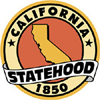

Description: The Physical map of California state USA showing major geographical features such as rivers, lakes, coastal outlines, topography and land formations.

The Large Detailed Physical Map of California offers an exhaustive visual guide to the state's multi-faceted geography. This map is nothing short of a topographical encyclopedia, highlighting the intricacies of California's physical landscape in remarkable detail.
From the state's extensive coastlines to the arid expanses of its deserts, from its towering mountains to its meandering rivers, the map provides an invaluable resource for educators, outdoor enthusiasts, researchers, and anyone captivated by the physical realm of California.
This guide aims to offer an elaborate walkthrough of each significant state geographical area, based on the map's delineations, to deepen the viewer's understanding and appreciation of California's natural wonders.
As depicted on the map, Southern California showcases several rivers, each with its own functions and ecological importance. The San Joaquin River stands out as a backbone for the region's agriculture, churning through the fertile San Joaquin Valley.
The Kings River runs through Kings Canyon, presenting a spectacle of nature's engineering. The Owens River serves a somewhat paradoxical role, winding its way through the arid Owens Valley, just east of the Sierra Nevada Mountains, as if to remind us of nature's contrasts.
Southern California is famous for its abundance of lakes. Big Bear Lake is nestled in the heart of the San Bernardino Mountains and offers many recreational activities, from boating to fishing. Lake Cachuma, another body of water worth mentioning, is a vital reservoir serving Santa Barbara County. On the other hand, Lake Havasu is a large reservoir straddling the border between California and Arizona and is famous for the London Bridge that was moved there in 1968.
Specifically highlighting the San Bernardino Mountains, the image showcases the singular hilly terrain of Southern California. Hiking and skiing enthusiasts can enjoy the stunning backdrop of these mountains, visible from cities such as San Bernardino and Riverside.
The map vividly details the Mojave Desert, which stretches across southeastern California and spills over into neighboring states. This desert is known for its extreme temperatures and unique ecosystems and is home to famous landmarks like Joshua Tree National Park.
Shifting our focus to the Northern part of the state, the Klamath and Trinity Rivers are immediate standouts. Originating from the Klamath Mountains, both rivers are critical for the area's ecology, including its famous redwood forests. The Russian River meanders through the lush landscapes of Sonoma and Mendocino counties, feeding vineyards and farms along its banks.
Lakes such as Lake Almanor, Clear Lake, and Shasta Lake punctuate Northern California's geography. Shasta Lake, in particular, deserves mention for its sheer size and importance as a water reservoir. Shasta Lake is a hub for water-based recreational activities created by damming the Sacramento River. Clear Lake, in Lake County, is another natural lake that offers beautiful vistas and excellent boating and fishing opportunities.
Northern California is dominated by mountain ranges like the Klamath Mountains and the Siskiyou Mountains, particularly prevalent in the northwestern corner. Thompson Peak in the Trinity Alps and Mount Eddy in the Klamath range are the most noteworthy peaks in this rugged, forested region.
While Northern California is more renowned for its forests and coastlines, it also features the Modoc Plateau, a high desert region in the northeastern part of the state. This area, as depicted on the map, offers a distinct contrast to the lush greenery found further west.
The Owens River and the lesser-known Amargosa River delineate Eastern California's landscape. The Owens River cuts a striking figure as it flows through the Owens Valley, nourishing the region's unique ecology despite its arid environment.
Mono Lake, a highly alkaline lake, and the stunningly beautiful Lake Tahoe are the iconic lakes of Eastern California. Known for its fame, Lake Tahoe is a lake that lies on the California-Nevada border. People adore it due to its crystal-clear water and the majestic presence of towering mountains surrounding it.
Mount Whitney takes the crown for the highest peak in the contiguous United States and is the crown jewel of Eastern California's mountains. Other peaks, such as Mount Dana and Mount Dubois, also feature prominently on the map, indicating their importance in the region's topography.
Eastern California is home to portions of the Great Basin Desert. Characterized by its arid conditions and unique flora and fauna, this desert adds another layer of complexity to the state's already diverse geography.
On the map, Western California shows the Salinas and El Rivers. The Salinas Valley is famous for having many farms and producing much food. It is known as the "Salad Bowl of the World" because the Salinas River flows through it.
Lake Sonoma and Manzanita Lake feature prominently in the western portion of the map. Lake Sonoma serves multiple purposes, including flood control, irrigation, and recreation.
The Coast Ranges, parallel to the Pacific Ocean, define much of Western California's topography. Mount Tamalpais, overlooking the San Francisco Bay, is a critical peak in this range.
Western California mainly lacks deserts, focusing more on its coastlines, fertile valleys, and mountain ranges.
The rivers in Central California are indispensable to its economy and way of life. The Stanislaus and Mokelumne Rivers featured prominently on the map, play vital roles in the Central Valley's agricultural sector, providing much-needed irrigation to vast expanses of farmland.
Donner Lake and Folsom Lake hold significant positions in this part of California. Donner Lake is known for its historical significance related to the Donner Party, while Folsom Lake is a considerable reservoir that provides water to the Sacramento region.
The Sierra Nevada mountain range dominates Central California's topographical profile. Standing tall and majestic, peaks like Mount Lyell and Mount Ritter are prominently marked on the map, emphasizing their significance in California's mountainous landscape.
Central California is primarily free of desert landscapes, focusing instead on its fertile valleys and towering mountain ranges.
To completely understand California's geography, one must explore its physical features like rivers, lakes, mountains, and deserts. The map effectively exhibits each of these details.
This map is not merely a cartographic representation but a comprehensive educational resource that captures the natural diversity of the Golden State. Whether you are an academic, a nature lover, a hiker, or a curious traveler, this guide offers an enriching and nuanced perspective on California's vast and varied landscape.
The California shoreline is exceptionally extensive, spanning over 800 miles in total. It is next to the Pacific Ocean. With its breathtaking natural landscapes, diverse environments, and significant economic relevance, it stands out as a place of remarkable beauty. Our Large, Detailed Physical Map of California offers an enriching visualization of this coastal belt, encapsulating its varied geographical features in great detail.
From the Santa Barbara Channel to the Channel Islands, from the Gulf of Santa Catalina to the majestically protruding Point Arena, the map portrays these landmarks fully, offering viewers a comprehensive and educational outlook on California's maritime topography.
Located between the California mainland and the Channel Islands, the Santa Barbara Channel is a significant maritime corridor rich in biodiversity. Marked prominently on the map, the Channel serves multiple purposes, from being a naval route for shipping to a vibrant habitat for marine life such as the endangered blue whale. It is also essential in moderating the climate of coastal communities like Santa Barbara and Ventura. The Channel is one of the state's most productive fishing grounds, making it economically crucial.
The Channel Islands are a bunch of eight islands close to Southern California. Each island has its unique landscape and environment. Prominently marked on the map, these islands are an essential conservation area, home to flora and fauna not found anywhere else on Earth. The islands offer a fascinating glimpse into California's geological and anthropological history and are accessible only by boat, preserving their pristine conditions.
The Gulf of Santa Catalina is another critical marine feature prominently displayed on the map. This body of water, located between the mainland and Santa Catalina Island, offers a range of recreational and commercial opportunities, from fishing to shipping to boating. Its unique geological formations provide rich habitats for marine life, making it a popular spot for scuba diving and underwater exploration.
The Pacific Ocean's vast expanse flanks the entire western edge of California. This body of water is represented in detail on the map, indicating its sheer size and its integral role in shaping California's geography, climate, and economy.
The coastline varies from sandy beaches to rugged cliffs, and its deep blue color on the map is a vivid reminder of its depth and vastness. The Pacific is crucial for international trade, fisheries, and tourism, serving as California's western frontier in every sense.
In Mendocino County, Point Arena is one of the westernmost points in the contiguous United States. It's featured prominently on the map, indicating its geographical importance. The area is known for the Point Arena Lighthouse, which has guided mariners along this treacherous part of the coast for over a century. The rugged cliffs offer panoramic views of the Pacific Ocean, and the region is rich in wildlife, including seals and various seabirds.
Besides the landmarks mentioned above, the map details other significant coastal features. For example, the San Francisco Bay Area is essential for shipping and has the famous Golden Gate Bridge. Further south, the rugged cliffs of Big Sur offer a dramatic contrast to the otherwise smooth coastal topography. The coastline is dotted with other noteworthy features like bays, estuaries, and more minor points, each contributing to the intricate mosaic that is California's Pacific coast.
The coastal features of California are as diverse as they are stunning. Each area, meticulously detailed on the Physical Map of California, tells a different story of ecological diversity, historical significance, and immense natural beauty.
This map serves as an indispensable guide for anyone interested in the geographical features that define California's coastline, offering detailed and accurate representations of each area. From students to scientists, from casual visitors to severe researchers, this map is an essential resource for understanding the intricate details that make California's coast one of the most remarkable in the world.

Counties and Road Map of California
Counties and Road map and map image of California.

Geographical Map of California
Geographical map and map image of California.

Regional Directory of United States of America
Information and guide about United States of America and websites with American topics.

Regional Directory of Europe
Information and guide about Europe and websites with European topics.

Regional Directory of Australia
Information and guide about Australia and websites with Australian topics.